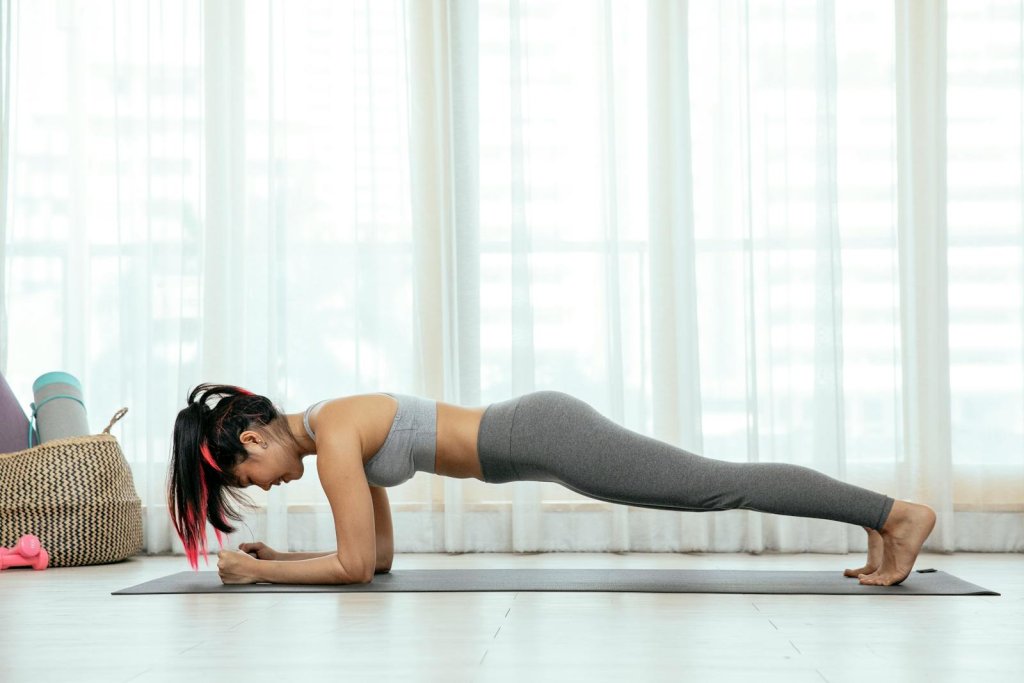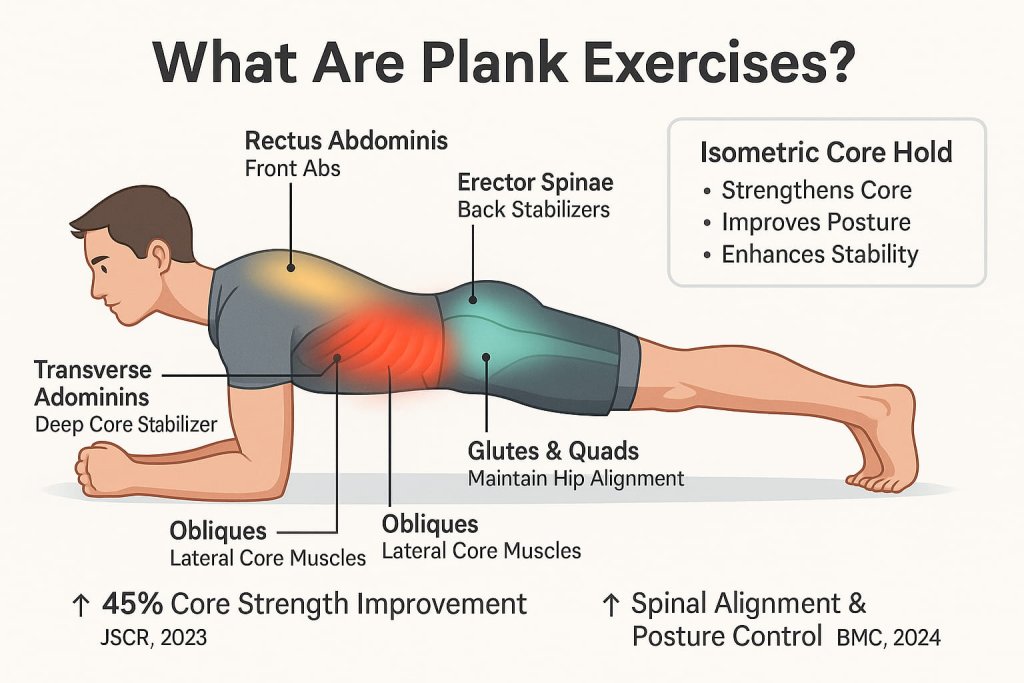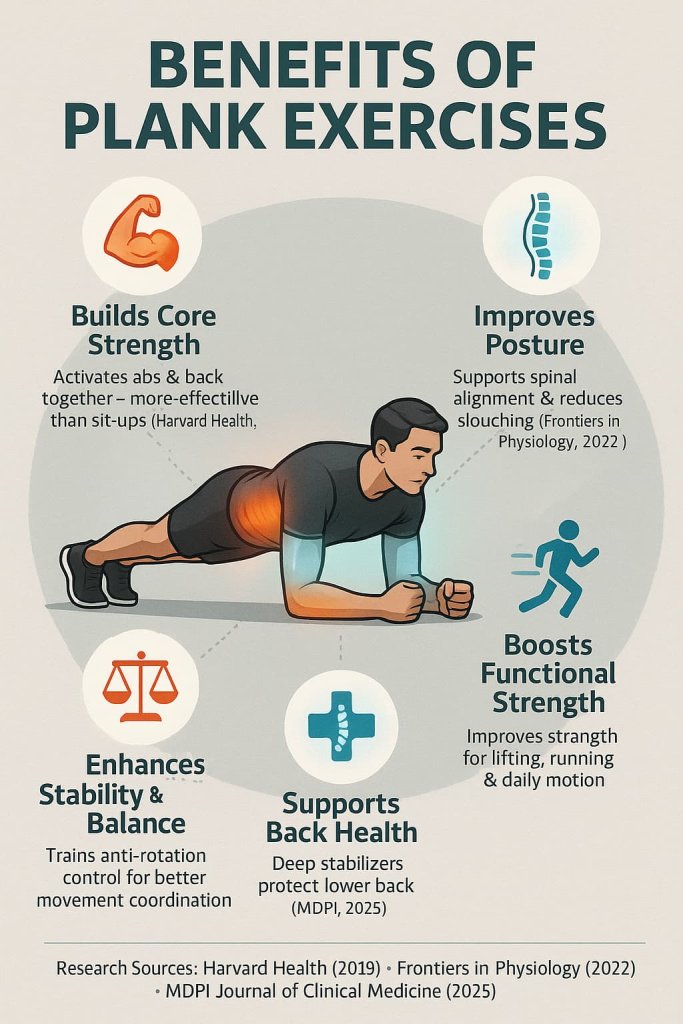Plank exercises are one of the most effective ways to build core strength, improve posture, and enhance overall stability — all without any equipment.
By holding your body in a straight line, supported by your arms and feet, planks activate multiple muscle groups that protect your spine and improve daily movement efficiency.

Understanding how to perform and progress planks is key for developing a strong, stable core that supports your posture, balance, and athletic performance. This guide explains the science behind planks, how to do them correctly, common variations, and what research says about their proven benefits.
What Are Plank Exercises?
A plank is an isometric core exercise, meaning the muscles contract without changing length. You hold a rigid position (like a “human bridge”), keeping your spine neutral while resisting gravity.

Main Muscles Worked
- Rectus abdominis (front abs)
- Transverse abdominis (deep stabilizer)
- Obliques (side core muscles)
- Erector spinae (back stabilizers)
- Shoulders, chest, glutes, and quads
Why It Works
Research in the Journal of Strength & Conditioning Research (2023) found that plank variations significantly improve abdominal muscle strength and balance in just eight weeks. Another study in BMC Musculoskeletal Disorders (2024) confirmed that core stability training, including planks, enhances spinal alignment and posture control.
How to Do a Basic Forearm Plank
How to do it:
- Lie face down on the floor.
- Place forearms on the ground, elbows under shoulders.
- Tuck your toes under and lift your body.
- Keep your body in a straight line from head to heels.
- Engage your abs, glutes, and legs.
- Hold for 20–60 seconds while breathing steadily.
Trainer Tip:
Avoid sagging your hips or arching your back. Imagine pulling your belly button toward your spine.
Benefits of Plank Exercises
1. Builds Core Strength
Planks engage multiple abdominal and back muscles simultaneously. According to Harvard Health Publishing (2019), planks are more efficient than sit-ups for total-core activation — strengthening both the front and back of your midsection.
2. Improves Posture and Spinal Alignment
Weak core muscles contribute to slouching and back pain. Planks strengthen the muscles that support your spine and pelvis, helping you maintain upright posture throughout the day.
A 2022 Frontiers in Physiology study reported that regular core training, including static holds like planks, can reduce spinal imbalance and postural strain.

3. Enhances Stability and Balance
Because planks challenge your body to stay still, they train anti-rotation and anti-extension stability — key for athletes and anyone who wants better coordination and movement control.
4. Supports Back Health
By activating deep stabilizers (transverse abdominis, multifidus), planks may reduce low-back pain and improve functional stability.
A 2025 MDPI Journal of Clinical Medicine study linked improved plank performance with stronger trunk stability among people with chronic back discomfort.
5. Boosts Functional Strength
Planks teach your muscles to work together, improving lifting, running, and daily movement efficiency. They’re foundational for athletic power and core endurance.
Popular Plank Variations
1. High Plank
Why it works:
The high plank increases shoulder and chest engagement while maintaining strong core activation. This variation improves upper-body stability and transitions easily into dynamic movements like push-ups and mountain climbers.
Muscles worked:
Core, shoulders, chest, triceps, glutes, quadriceps.
How to do it:
- Start on your hands and toes, wrists directly under shoulders.
- Keep your body in a straight line from head to heels.
- Engage your abs and glutes to avoid hip sag.
- Hold for 30–60 seconds while maintaining steady breathing.
Trainer Tip:
Spread your fingers wide and press evenly through your palms to protect your wrists and shoulders.
2. Side Plank
Why it works:
The side plank targets the obliques and hip stabilizers, improving lateral stability and core symmetry. It’s an effective way to strengthen muscles that support rotation and posture.
Muscles worked:
Obliques, transverse abdominis, shoulders, glute medius, hip adductors.
How to do it:
- Lie on one side with your elbow under your shoulder and legs stacked.
- Lift your hips off the floor, forming a straight line from head to feet.
- Hold for 20–45 seconds per side, keeping core and glutes tight.
Trainer Tip:
For beginners, bend the lower knee for support. Advanced lifters can raise the top leg for extra challenge and glute activation.
3. Reverse Plank
Why it works:
This variation strengthens the posterior chain — muscles often neglected in core training. It enhances shoulder stability, posture, and counteracts forward rounding from long hours of sitting.
A 2022 Journal of Physical Therapy Science study found that performing five sets of 30-second reverse planks improved shoulder posture and muscle balance.
Muscles worked:
Glutes, hamstrings, lower back, shoulders, triceps, posterior deltoids.
How to do it:
- Sit on the floor with legs extended and hands behind you, fingers pointing toward feet.
- Press into your palms and heels to lift your hips until your body forms a straight line.
- Keep your neck neutral and squeeze your glutes.
- Hold for 20–45 seconds.
Trainer Tip:
Avoid letting your hips drop — think about pushing your chest upward and squeezing your glutes to keep alignment.
4. Plank with Shoulder Tap
Why it works:
This dynamic version challenges your core’s ability to resist rotation, enhancing stability and coordination. It’s ideal for developing balance and control through the trunk and shoulders.
Muscles worked:
Rectus abdominis, obliques, shoulders, triceps, glutes, and spinal stabilizers.
How to do it:
- Begin in a high plank with feet hip-width apart.
- Lift your right hand to tap your left shoulder, then return it to the floor.
- Alternate sides in a slow, controlled rhythm.
- Keep your hips square to the ground throughout.
Trainer Tip:
Widen your stance slightly to increase balance and reduce hip rotation. Focus on keeping your torso stable instead of rushing reps.
5. Plank Leg Lift
Why it works:
Adding a leg lift activates the glutes and hamstrings while maintaining core stability. This variation enhances balance, posterior strength, and coordination between the upper and lower body.
Muscles worked:
Glutes, hamstrings, lower back, core, shoulders.
How to do it:
- Start in a forearm or high plank position.
- Lift one leg slowly until it aligns with your hips.
- Hold for 2–3 seconds, then lower it back down.
- Repeat with the other leg for 10–12 reps per side.
Trainer Tip:
Keep your hips steady — imagine balancing a glass of water on your lower back. Focus on control and even breathing rather than speed.
How Often to Do Plank Exercises
- Beginners: 3–4 sets of 20–30 seconds, 3–4 days per week
- Intermediate: 3–4 sets of 45–60 seconds
- Advanced: Add dynamic variations or unstable surfaces (stability ball, sliders)
Progression Tip:
Rather than extending hold time endlessly, increase difficulty with controlled movement, resistance bands, or unilateral planks.
Common Mistakes to Avoid
- Sagging hips — reduces core tension and strains the lower back.
- Neck misalignment — keep gaze down to maintain neutral spine.
- Holding your breath — breathe normally throughout.
- Overarching the back — tighten glutes and abs for alignment.
Who Should Try Plank Exercises
Planks are suitable for:
- Beginners learning core control
- Athletes seeking trunk stability
- Office workers improving posture
- Older adults needing spine support
Avoid or modify if:
You have wrist, shoulder, or severe low-back pain — opt for forearm or incline versions instead.
Safety Tips
- Warm up for 3–5 minutes (cat-cow stretch, bird-dog, or glute bridge).
- Stop if you feel sharp pain or pressure in your lower back.
- Gradually increase hold time to avoid fatigue-related form breakdown.
- Keep breathing — avoid breath-holding or bracing excessively.
Sample 5-Minute Daily Plank Routine
| Exercise | Duration |
|---|---|
| Forearm Plank | 30 sec |
| Side Plank (Right) | 30 sec |
| Side Plank (Left) | 30 sec |
| High Plank Shoulder Taps | 30 sec |
| Reverse Plank | 30 sec |
| Rest & Repeat | 1 min |
Perform this circuit 2–3 times weekly for noticeable improvements in posture and core tone.
FAQ
1. How long should I hold a plank?
Start with 20–30 seconds and gradually increase up to 60–90 seconds with perfect form.
2. Are planks better than sit-ups?
Yes — planks strengthen more core muscles and are safer for the spine (Harvard Health, 2019).
3. Can planks reduce belly fat?
They improve muscle tone but don’t directly burn fat — combine with cardio and proper nutrition.
4. Should I do planks every day?
It’s fine to plank daily if your core is recovered; alternate variations for best results.
5. Are planks safe for people with back pain?
Yes, if done correctly — studies show planks support spinal stability. Start with shorter holds and proper guidance.
6. What’s the best time to do planks?
Anytime — add them at the end of workouts or as a morning core activator.
Conclusion
Plank exercises are simple, scalable, and scientifically proven to build core strength, improve posture, and enhance overall stability.
Whether you’re a beginner or an athlete, a few minutes of consistent plank training can help strengthen your foundation for better movement and long-term spinal health.
Start today — commit to a 30-day plank challenge and feel the difference in your strength, balance, and confidence.
References
- Mayo Clinic (2024) — Core Exercises: Why You Should Strengthen Your Core
https://www.mayoclinic.org/healthy-lifestyle/fitness/in-depth/core-exercises/art-20044751 - Tsartsapakis I, et al. (2024) — Core Stability Exercises & Deep Core Thickness (Side Plank/Bird-Dog)
https://pmc.ncbi.nlm.nih.gov/articles/PMC11036226/ - Koo DK, et al. (2022) — Reverse Plank: Immediate Effects on Muscle Thickness & Forward-Shoulder Posture
https://pmc.ncbi.nlm.nih.gov/articles/PMC9624361/ - MDPI Journal of Clinical Medicine (2024) — Trunk Stability, Core Endurance & Clinical Considerations
https://www.mdpi.com/2077-0383/14/11/3926 - Kanlı K, et al. (2024) — Core Stabilization + Aerobic Exercise in Chronic Low-Back Pain (Lumbar Stabilizers/Diaphragm)
https://pmc.ncbi.nlm.nih.gov/articles/PMC11639492/ - McGill SM, et al. (1999) — Endurance Times for Low-Back Stabilization (Plank/Side-Bridge Norms)
https://pubmed.ncbi.nlm.nih.gov/10453772/ - Tong TK, et al. (2014) — Sport-Specific Endurance Plank Test (Validity & Reliability)
https://www.sciencedirect.com/science/article/abs/pii/S1466853X13000151
